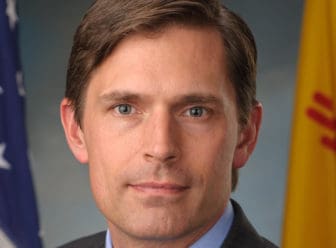COMMENTARY: Our land is an integral part of who we are as New Mexicans. The Land of Enchantment is home to many national forests, parks, monuments, wildlife refuges, and other public lands.
These are outdoor treasures that are owned by all of us, from ranchers who graze their livestock, to backcountry hunters and anglers, to families who take their kids on a weekend nature hike or camping trip. And the outdoor recreation economy our public lands support is responsible for 68,000 jobs and $6.1 billion of annual economic activity in our state.

Courtesy photo
Martin Heinrich
The idea of shared, public land has deep roots in New Mexico. Aldo Leopold, U.S. Senators Clinton P. Anderson and Jeff Bingaman, and Secretary of the Interior Stewart Udall all played major roles in creating and protecting the places we go to seek refuge, responsibly managing our natural resources, and preserving our cultural heritage.
Leopold, who had the vision and influence to protect 500,000 acres of mountains, rivers, and mesas in New Mexico, which eventually became the Gila Wilderness, wrote in his Sand County Almanac, “When we see land as a community to which we belong, we may begin to use it with love and respect.”
In the Senate, in partnership with U.S. Senator Tom Udall, I am proud to work with communities across New Mexico to build on our state’s rich legacy of conservation.
Over the last four years, despite a tough partisan climate in Washington, New Mexicans have celebrated major conservation victories.
Together we created the Columbine-Hondo Wilderness in Taos County, home to some of the best elk, mule deer, and bighorn sheep habitat in New Mexico. Designating this area at the head waters of the Red River and Rio Hondo had broad community support from Taos Pueblo, local government leaders, business owners, land grant heirs, acequia parcientes, sportsmen, ranchers, and conservationists.
After extensive input from local residents, sportsmen, business owners, and elected officials, we transitioned the Valles Caldera National Preserve to National Park Service management, opening this stunning landscape inside the crater of a collapsed super-volcano to greater public access. The preserve model also ensured that hunting and fishing remain central activities for the public to enjoy.
In 2013, New Mexico welcomed the designation the Rio Grande del Norte National Monument near Taos and the following year the designation of Organ Mountains-Desert Peaks in Doña Ana County. Both of these community-driven monuments permanently protect iconic landscapes, increase recreational access, and are proving to be good for business. New visitors from across the country and around the world are fueling New Mexico’s tourism industry and creating new jobs.
I was also proud to stand with the community in Albuquerque’s South Valley and secure resources to turn the Valle de Oro National Wildlife Refuge, a 570-acre oasis in the Rio Grande Bosque, into a place filled with educational and recreational programs. There is so much opportunity at Valle de Oro to help New Mexico kids discover the incredible natural heritage of our state right in their backyard, while supporting vital river and habitat conservation.
Last year, I also secured a three-year extension and $450 million for the Land and Water Conservation Fund (LWCF), an increase of 47 percent over the previous year’s funding. For more than 50 years, this vital conservation program has protected some of our most treasured public lands and created many community parks across the state. I will continue fighting to fully fund and permanently reauthorize LWCF so New Mexico’s landscapes will be protected and accessible for our children and future generations to enjoy.
While we have much to celebrate in conservation gains, we have also witnessed renewed threats from a growing campaign of special interests and extremist groups to seize and sell off the American people’s public lands.
As the instigators of the attack on the Malheur National Wildlife Refuge in Oregon begin to face trial, I sincerely hope that they will see consequences for their dangerous actions. New Mexicans serve as park rangers and wildlife biologists, volunteer in visitor centers, and routinely hunt, fish, and camp with their families on these public lands. The possibility that their offices and community buildings may be overrun in an armed siege is simply unacceptable.
The idea that these lands should be transferred to states or private auctions is equally concerning. Proponents of land giveaway bills in state legislatures across the West argue that states are better equipped to manage our natural wonders than the United States Forest Service or the Bureau of Land Management. But what they don’t say is that their proposals would raise the possibility that some of the lands would be turned over to the highest bidder and that Western taxpayers would be saddled with the costs of overseeing the rest.
This would result in a proliferation of locked gates and “No Trespassing” signs in places that have been open to the public and used for generations. And it would devastate outdoor traditions like hunting, camping, and fishing that are among the pillars of Western culture and a thriving outdoor recreation economy.
Questions of how to best use our public lands to promote the public good can sometimes be contentious and controversial. But that’s exactly why we all need to be at the table making those decisions. There are real problems that need to be solved, like creating more access points for recreation, hunting, and fishing, as I have proposed doing with a bill I introduced called the HUNT Act. But these are problems we can solve because of the very fact that these lands are public, and we each have a voice in their management.
As we celebrate Public Lands Day, I remain deeply committed to standing with New Mexicans to protect and conserve our public lands, watersheds, and wildlife for all to enjoy. I can’t think of anything more fundamentally American than defending the land we all love.
Martin Heinrich, a Democrat, represents New Mexico in the U.S. Senate.